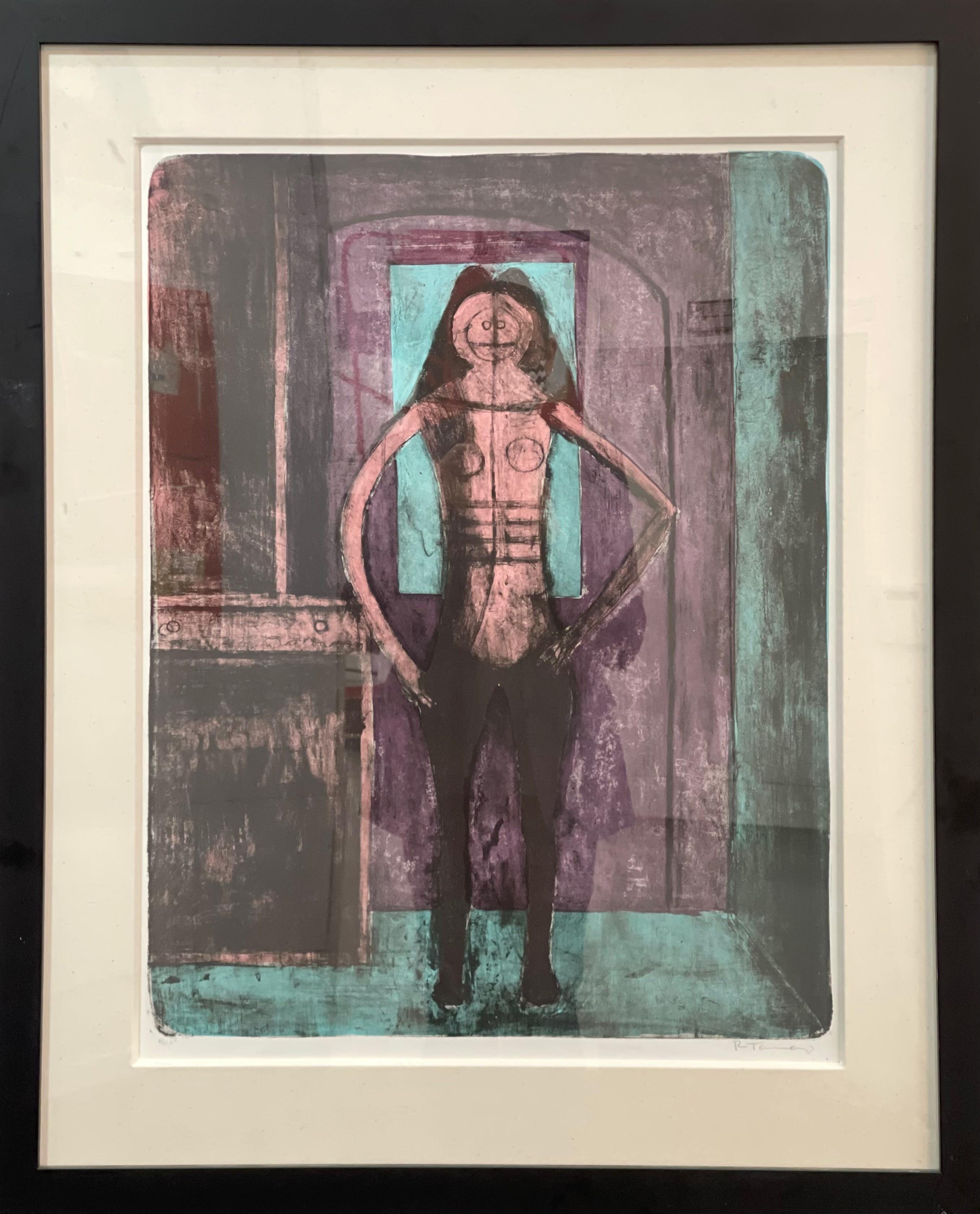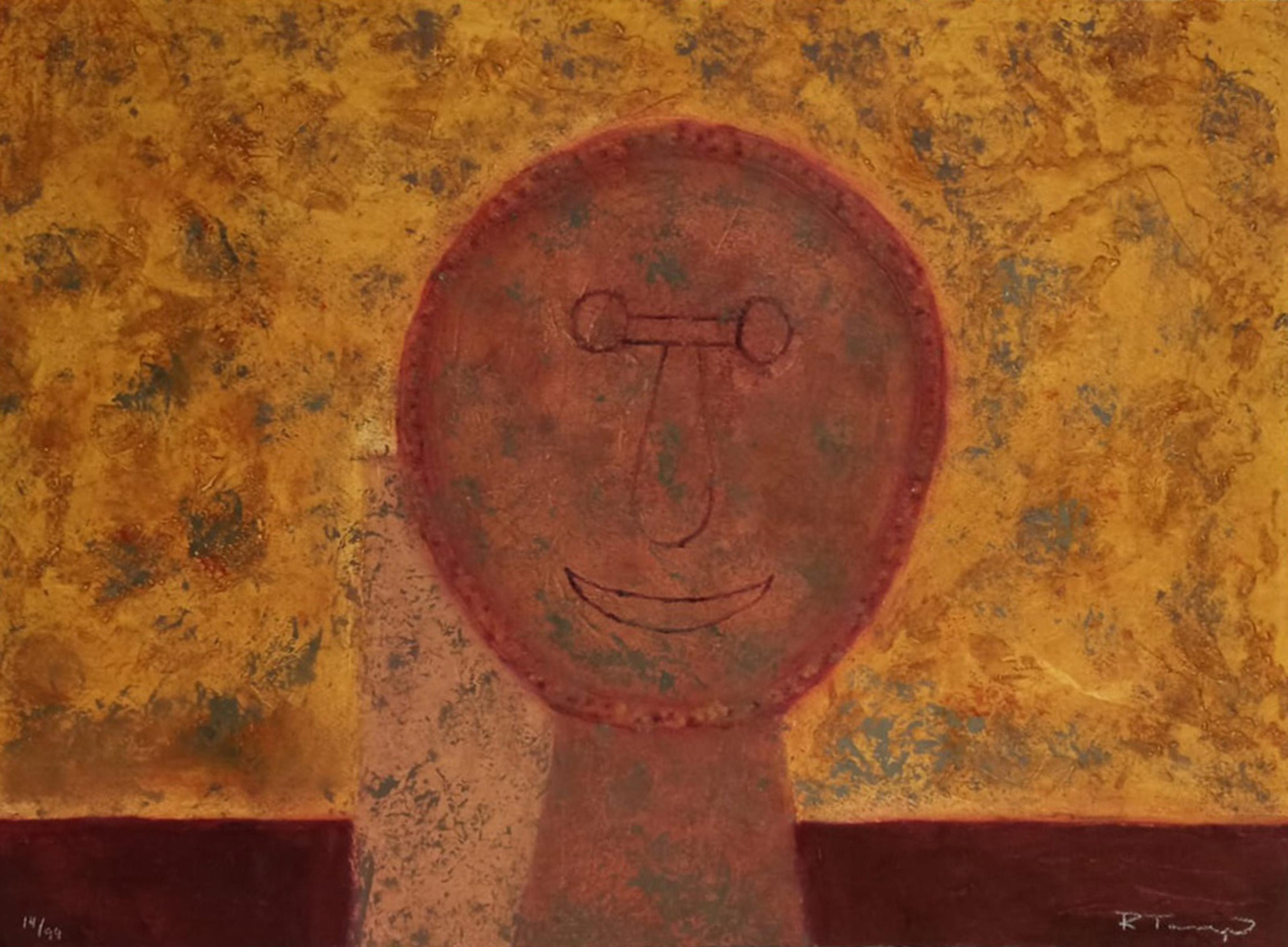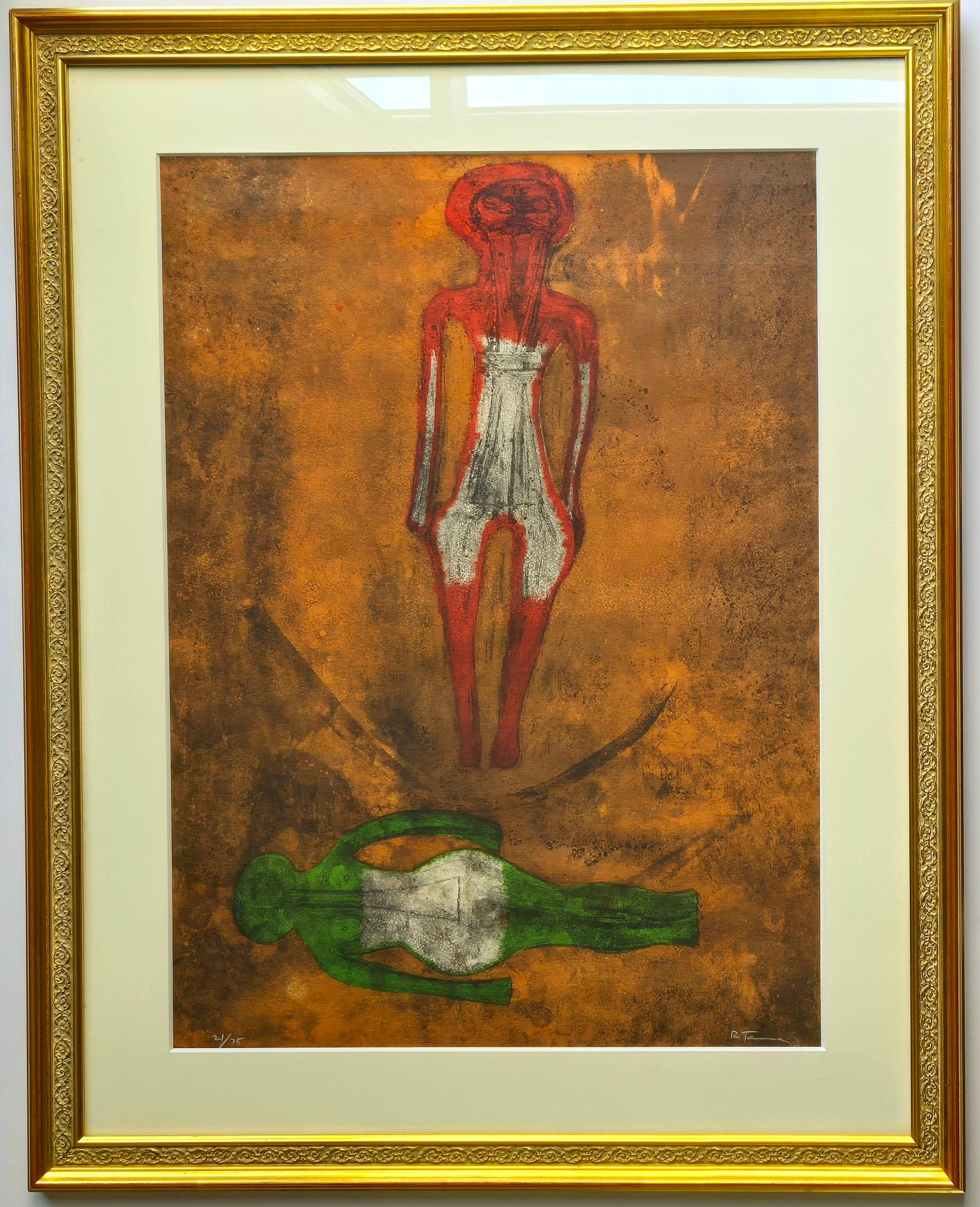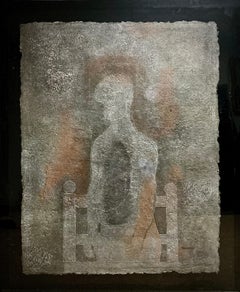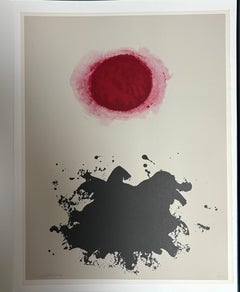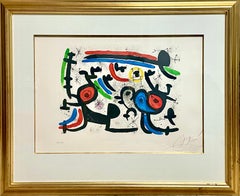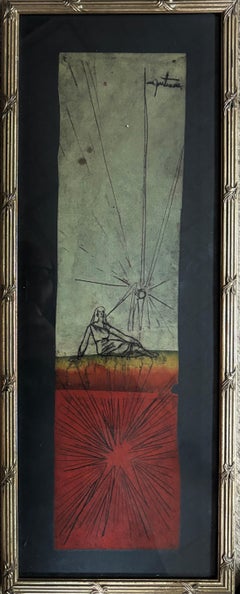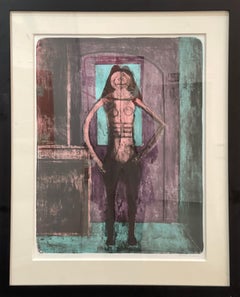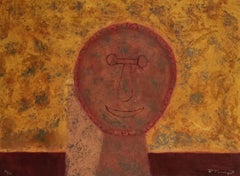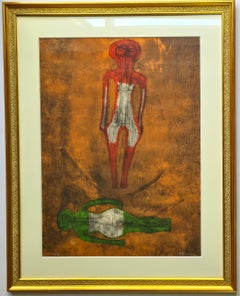Want more images or videos?
Request additional images or videos from the seller
1 of 8
Rufino TamayoFemme Souriante
$6,000
£4,581.49
€5,216.19
CA$8,424.95
A$9,210.12
CHF 4,872.57
MX$110,213.85
NOK 61,996.41
SEK 56,751.44
DKK 38,961.68
About the Item
in excellent condition signed and numbered
- Creator:Rufino Tamayo (1899-1991, Mexican)
- Dimensions:Height: 36 in (91.44 cm)Width: 30 in (76.2 cm)Depth: 1 in (2.54 cm)
- Medium:
- Period:
- Condition:
- Gallery Location:Warren, NJ
- Reference Number:1stDibs: LU2336211700822
Rufino Tamayo
Rufino Tamayo was born in Oaxaca, Mexico, in 1899 to parents Manuel Arellanes and Florentina Tamayo. Tamayo was active in the mid-20th century in Mexico and New York, painting figurative abstraction with surrealist influences. Although Tamayo studied drawing at the Academy of Art at San Carlos as a young adult, he became dissatisfied and eventually decided to study on his own.
About the Seller
5.0
Vetted Professional Seller
Every seller passes strict standards for authenticity and reliability
Established in 2023
1stDibs seller since 2023
67 sales on 1stDibs
Typical response time: <1 hour
- ShippingRetrieving quote...Shipping from: Warren, NJ
- Return Policy
More From This Seller
View AllHombre en gris, 1981
By Rufino Tamayo
Located in Warren, NJ
in good condition some minor scratching on the plexiglass
Category
1980s Prints and Multiples
Materials
Lithograph
"Untitled" (From the Flight Portfolio)
By Adolph Gottlieb
Located in Warren, NJ
Adolph Gottilieb (1903-1974), New York, 1969, signed "161/250" and dated 1969 . In good condition Unframed. Measures 24x19
Category
20th Century Prints and Multiples
Materials
Lithograph
"Les amoureux et luna park II"
By Joan Miró
Located in Warren, NJ
Frame: 47.5 x 39.5 x 2
Picture: 32.5 x 22.5
Frame has a lot of ware
Picture itself is in excellent condition
Category
1980s Prints and Multiples
Materials
Lithograph
“Girl with star”
By Margaret Putnam
Located in Warren, NJ
Image: 16 3/4 x 4 1/4 inches
Overall: 20 1/4 x 8 inches
In good condition measures 20x8
Category
20th Century Paintings
Materials
Oil
"nude woman"
By Moses Soyer
Located in Warren, NJ
Original Drawing on paper
Frame hand a lot of wear. There’s a few marks that look like they can be wiped off but they’re behind the frame. A few stains on the matte
Frame: 32 x 27 x ...
Category
1940s Drawings and Watercolor Paintings
Materials
Charcoal
Canto General by Pablo Neruda, suite of 10
By David Alfaro Siqueiros
Located in Warren, NJ
signed and editioned 40/200 in lower margins of each
Canto General was Pablo Neruda's tenth book of poems, first published in Mexico in 1950, and illustrated with designs by his frie...
Category
20th Century Prints and Multiples
Materials
Lithograph
You May Also Like
Femme au Collant Noir, 1969, (4/150)
By Rufino Tamayo
Located in San Francisco, CA
Rufino Tamayo
Femme au Collant Noir, 1969
Color lithograph
Unframed dimensions: 27.50 x 21 in
Framed dimensions: 37.625 x 30.75
Edition 4/150
This limited edition color lithograph i...
Category
1960s Abstract Portrait Prints
Materials
Color, Lithograph
Torso de Mujer
By Rufino Tamayo
Located in San Francisco, CA
This artwork titled "Torso de Mujer (Torso de Femmee)" from the suite "The Mujeres File" 1969 is an original colors lithograph on Wove paper by renown Mexican artist Rufino Tamayo, 1899-1991. It is hand signed and inscribed H.C. (Hors Commerce) in pencil by the artist. The image size is 26.85 x 21 inches, framed size is 40.75 x 33 inches. Published by Touchtone Publisher, New York, printed by Ateliers Desjobert, Paris. Referenced and pictured in the artist's catalogue raisonne by Pereda, plate #108 page 107. Custom framed in a wooden gold frame, with gold bevel and light beige fabric matting. It is in excellent condition.
About the artist:
A native of Oaxaca in Southern Mexico, Rufino Tamayo's father was a shoemaker, and his mother a seamstress. Some accounts state that he was descended from Zapotec Indians, but he was actually 'mestizo' - of mixed indigenous/European ancestry. (Santa Barbara Museum of Art). He began painting at age 11. Orphaned at the age of 12, Tamayo moved to Mexico City, where he was raised by his maternal aunt who owned a wholesale fruit business.
In 1917, he entered the San Carlos Academy of Fine Arts, but left soon after to pursue independent study. Four years later, Tamayo was appointed the head designer of the department of ethnographic drawings at the National Museum of Archaeology in Mexico City. There he was surrounded by pre-Colombian objects, an aesthetic inspiration that would play a pivotal role in his life. In his own work, Tamayo integrated the forms and tones of pre-Columbian ceramics...
Category
Mid-20th Century Modern Figurative Prints
Materials
Lithograph
Cabeza Sobre Fondo Verde, Surrealist Etching by Rufino Tamayo
By Rufino Tamayo
Located in Long Island City, NY
Rufino Tamayo, Mexican (1899 - 1991) - Cabeza Sobre Fondo Verde, Portfolio: Rufino Tamayo 15 aquafuertes, Year: 1979, Medium: Etching, signed and numbered in crayon, Edition: 14/...
Category
1970s Surrealist Portrait Prints
Materials
Etching
Rufino Tamayo -- Dos Figuras
By Rufino Tamayo
Located in BRUCE, ACT
Rufino Tamayo
Dos Figuras, 1973
Lithograph in colors
Hand-signed lower right in white crayon
Numbered 21/75 cm lower left in white crayon
Sheet size 76 x 56 cm
Frame size 98 x 80 x ...
Category
1970s Prints and Multiples
Materials
Lithograph
Carnavalesque
By Rufino Tamayo
Located in San Francisco, CA
This artwork titled "Carnavalesque" from the suite "The Mujeres File" 1969 is an original colors lithograph on BFK Rives paper by renown Mexican artist Rufino Tamayo, 1899-1991. It i...
Category
Mid-20th Century Modern Figurative Prints
Materials
Lithograph
Mascara Roja
By Rufino Tamayo
Located in San Francisco, CA
This artwork titled "Mascara Roja" 1969 is an original colors lithograph on B.F.K. Rives paper by renown Mexican artist Rufino Tamayo, 1899-1991. It is hand signed and inscribed H.C. (Hors Commerce) in pencil by the artist. The image size is 21 x 27.25 inches, framed size is 37.25 x 42 inches. Published by Touchtone Publisher, New York, printed by Ateliers Desjobert, Paris. Referenced and pictured in the artist's catalogue raisonne by Pereda, plate #124. Custom framed in a wooden gold leaf frame, with gold and red spacer and fabric matting. It is in excellent condition.
About the artist:
A native of Oaxaca in Southern Mexico, Rufino Tamayo's father was a shoemaker, and his mother a seamstress. Some accounts state that he was descended from Zapotec Indians, but he was actually 'mestizo' - of mixed indigenous/European ancestry. (Santa Barbara Museum of Art). He began painting at age 11. Orphaned at the age of 12, Tamayo moved to Mexico City, where he was raised by his maternal aunt who owned a wholesale fruit business.
In 1917, he entered the San Carlos Academy of Fine Arts, but left soon after to pursue independent study. Four years later, Tamayo was appointed the head designer of the department of ethnographic drawings at the National Museum of Archaeology in Mexico City. There he was surrounded by pre-Colombian objects, an aesthetic inspiration that would play a pivotal role in his life. In his own work, Tamayo integrated the forms and tones of pre-Columbian ceramics into his early still lives and portraits of Mexican men and women.
In the early 1920s he also taught art classes in Mexico City's public schools. Despite his involvement in Mexican history, he did not subscribe to the idea of art as nationalistic propaganda. Modern Mexican art at that time was dominated by 'The Three Great Ones' : Diego Rivera, Jose Clemente Orozco, and David Alfaro Siqueros, but Tamayo began to be noted as someone 'new' and different' for his blending of the aesthetics of post Revolutionary Mexico with the vanguard artists of Europe and the United States.
After the Mexican Revolution, he focused on creating his own identity in his work, expressing what he thought was the traditional Mexico, and refusing to follow the political trends of his contemporary artists. This caused some to see him as a 'traitor' to the political cause, and he felt it difficult to freely express himself in his art. As a result, he decided to leave Mexico in 1926 and move to New York, along with his friend, the composer Carlos Chavez. The first exhibition of Tamayo's work in the United States was held at the Weyhe Gallery, New York, in that same year. The show was successful, and Tamayo was praised for his 'authentic' status as a Mexican of 'indigenous heritage', and for his internationally appealing Modernist aesthetic. (Santa Barbara Museum of Art).
Throughout the late thirties and early forties New York's Valentine Gallery gave him shows. For nine years, beginning in 1938, he taught at the Dalton School in New York.
In 1929, some health problems led him to return to Mexico for treatment. While there he took a series of teaching jobs. During this period he became romantically involved with the artist Maria Izquierdo...
Category
Mid-20th Century Modern Figurative Prints
Materials
Lithograph
More Ways To Browse
Pace Columbus
Painting Open Window
Picasso 156
Picasso Nude Etching
Picasso Picador
Plm Poster
Roy Lichtenstein Signed
Salon Cent
Salvador Dali Hand Signed
Scottish Lithograph
Silk Screen Pop Art
Surrealist Exhibition Poster
Twa Travel Poster
Vintage Hopi Kachina
Vintage Mont Blanc
Vintage Twa Travel Posters
Warhol Gay
Yvette Guilbert Lithograph
